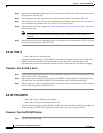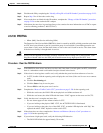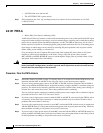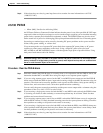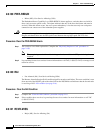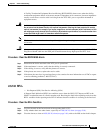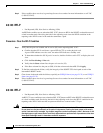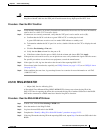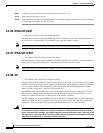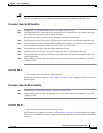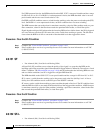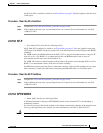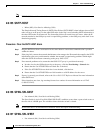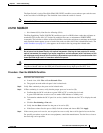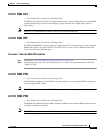
2-104
Cisco ONS 15327 Troubleshooting Guide, R3.4
March 2004
Chapter 2 Alarm Troubleshooting
Alarm Procedures
Step 6 Complete the “Change a Ring ID Number” procedure on page 2-125.
Step 7 Verify that the ring map is correct.
Step 8 If the alarm does not clear, log onto http://www.cisco.com/tac for more information or call TAC to report
a service-affecting problem (1-800-553-2447).
2.6.146 RING-SW-EAST
• Not Alarmed (NA), Non-Service Affecting (NSA)
The Ring Switch is Active East Side (RING-SW-EAST) condition occurs when a ring switch occurs at
the east side of two-fiber BLSR. The condition clears when the switch is cleared.
Note RING-SW-EAST is an informational condition. It does not require troubleshooting.
2.6.147 RING-SW-WEST
• Not Alarmed (NA), Non-Service Affecting (NSA)
The Ring Switch is Active West Side (RING-SW-WEST) condition occurs when a ring switch occurs at
the west side of a two-fiber BLSR. The condition clears when the switch is cleared.
Note RING-SW-WEST is an informational condition. It does not require troubleshooting.
2.6.148 SD
• Not Alarmed (NA), Non-Service Affecting (NSA)
A Signal Degrade (SD) condition occurs when the quality of the signal is so poor that the bit error rate
on the incoming optical line passed the signal degrade threshold. Signal degrade is defined by Telcordia
as a soft failure condition. SD and signal fail (SF) both monitor the incoming BER and are similar
alarms, but SD is triggered at a lower bit error rate than SF.
The BER threshold on the ONS 15327 is user provisionable and has a range for SD from 10
–9
to 10
–5
.
SD-L causes a switch from the working card to the protect card at the line (facility) level. A line or
facility level SD condition travels on the B2 byte of the SONET overhead.
The SD condition clears when the BER level falls to one-tenth of the threshold level that triggered the
condition. A BER increase is sometimes caused by a physical fiber problem, including a faulty fiber
connection, a bend in the fiber that exceeds the permitted bend radius, or a bad fiber splice.
Warning
Invisible laser radiation might be emitted from the end of the unterminated fiber cable or connector.
Do not stare into the beam directly with optical instruments. Viewing the laser output with certain
optical instruments (for example, eye loupes, magnifiers, and microscopes) within a distance of 100
mm might pose an eye hazard. Use of controls or adjustments or performance of procedures other than
those specified might result in hazardous radiation exposure.



